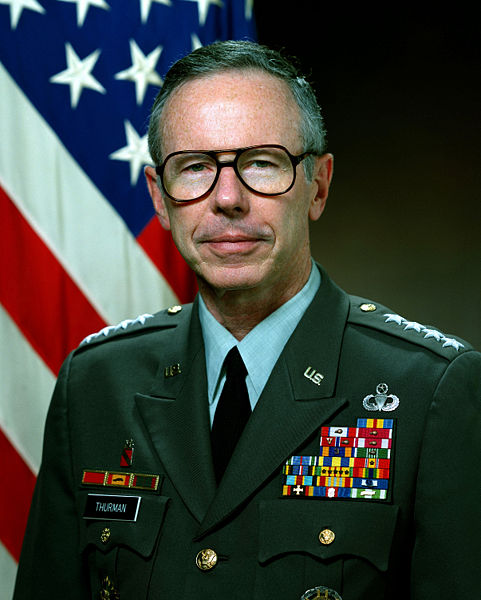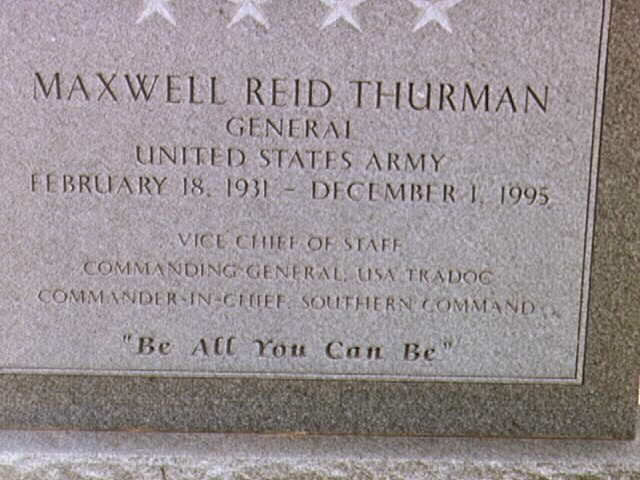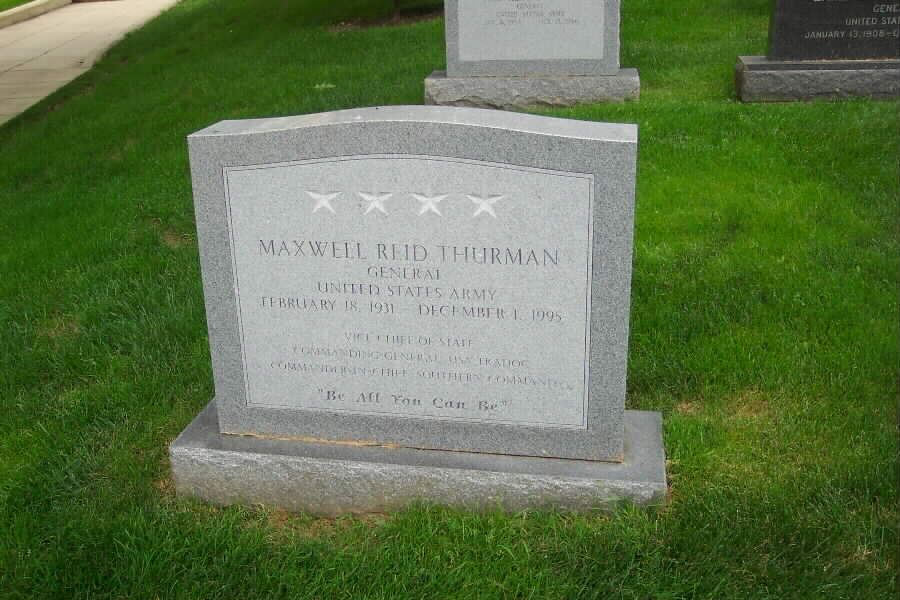THURMAN, GENERAL MAXWELL R.
February 18, 1931 – December 1, 1995
“Do not stand by my grave and weep … I am not there; I do not sleep. When you awaken in the morning’s hush, I am the swift uplifting rush of quiet birds circling in flight. Do not stand by my grave and cry … I am not there. I did not die.”
— Royster
Retired Army General Maxwell Thurman, who led the 1989 invasion of Panama and was a principal architect of the all-volunteer Army, died Friday, December 1, 1995, at Walter Reed Army Medical Center. Thurman, 64, had been diagnosed with leukemia in 1990.

Dubbed “Mad Max” and “Maxatollah” by colleagues for his aggressive style, Thurman delayed his retirement at the request of the Bush administration so he could spearhead the effort to oust General Manuel Noriega’s regime.
General John Shalikashvili, chairman of the Joint Chiefs of Staff, called Thurman “a remarkable soldier” who loved the Army. “He was a visionary who carved out a path for the Army of today and, by doing so, showed us courage, talent, intelligence and strength of character,” Shalikashvili said.
Thurman was named commander of the US Southern Command, based at Quarry Heights, Panama, in September 1989. Responsible for US forces in South and Central America, Thurman pledged at the time to confront “tyranny in all its insidious forms.” He was widely credited with persuading the Pentagon leadership and the Bush dministration to use military force against Noriega’s regime.
Thurman retired in February 1991 after a 37-year career. He had learned he had an aggressive form of leukemia in July 1990. The general made his reputation as an aggressive, take-charge commander — a man known, in the words of one officer, for “driving his staff crazy because he was a bachelor and the guy never went home.”
Born Feb 18, 1931, in High Point, NC, he was a graduate of North Carolina State University in Raleigh, where he enrolled in ROTC and got his officer’s commission. Thurman held a variety of staff and command positions in Europe and the United States, and served in Vietnam, first as a corps intelligence adviser and later as commander of the 2nd Battalion, 35th Field Artillery, during the Tet offensive. That 1968 battle was considered a public disaster for the United States but a tactical victory in the field for US forces.
He held numerous key Army posts, including vice chief of staff and commanding general of the U.S. Army Training and Doctrine Command at Fort Monroe, Virginia, before taking the top spot at Southern Command. Thurman headed the Army’s Recruiting Command at Fort Sheridan, Illinois, where he worked to develop the service’s “Be all that you can be” campaign. It was during these years, in the mid-1980s that Thurman is credited with vastly improving the quality of the average soldier. Under Thurman’s guidance, according to an Army release, “the modern professional Army we now possess came into existence.”
Thurman is survived by his brother, retired Army Lieutenant General John R. Thurman III of Alexandria, Virginia. He is to be buried Thursday at Arlington National Cemetery. (Section 30)
One of the men most responsible for the Army’s positive image and success through the 1980s succumbed to lengthy bout with cancer. Retired General Maxwell Reid Thurman died December 1, 1995 at Walter Reed Army Medical Center in Washington. He was 64. A funeral service will be held on December 7, 1995 at the Fort Myer, Virginia, chapel, followed by interment at Arlington National Cemetery.
Thurman’s image as a workaholic – captured by the nickname “Mad Max” – was as widespread as his reputation as a master organizer. His credits include reversing the downward slide of Army recruiting and commanding the 1989 invasion of Panama. Thurman was diagnosed with acute myelogenous leukemia while still commander in chief of US Southern Command shortly after Operation Just Cause, which ousted strongman Manuel Noriega. He conducted SOUTHCOM business from his hospital bed at Johns Hopkins Hospital in Baltimore after he was admitted for treatment in July 1990.
He retired from active duty in February 1991. But in between returns to the hospital for treatment, he kept a rigorous schedule of travel to conferences and speaking engagements, taking every opportunity to talk with or about soldiers and the Army. That retirement was his second. He had one foot out the door in September 1989, when he was set to retire as commanding general of US Army Training and Doctrine Command at Fort Monroe, Virginia. Instead, he was called to the Pentagon and given charge over the US multi-service command in Panama. His elaborate invasion plan involved conventional and special operations forces from units in the United States as well as Panama which overwhelmed Noreiga’s forces.
Before serving as vice chief of staff and top personnel officer, Thurman was commanding general of US Army Recruiting Command. When he took command in 1979, enlisting was generally viewed as an option for slackers. Behind the slogan, “Be all you can be,” Thurman was able to blot out that perception and begin a trend of attracting high-quality recruits. A graduate of North Carolina State University and commissioned in Field Artillery, Thurman served two tours in Vietnam, including a battalion command. His decorations and awards over his 37-year career include the Defense Distinguished Service Medal, the Distinguished Service Medal, the Legion of Merit and the Bronze Star for valor. Section 30, Grave 416-A-LH, Arlington National Cemetery.
THURMAN, MAXWELL R
- GEN US ARMY
- VETERAN SERVICE DATES: 03/01/1947 – 03/01/1991
- DATE OF BIRTH: 02/18/1931
- DATE OF DEATH: 11/30/1995
- DATE OF INTERMENT: 12/07/1995
- BURIED AT: SECTION 30 SITE 416-A LH
- ARLINGTON NATIONAL CEMETERY

Michael Robert Patterson was born in Arlington and is the son of a former officer of the US Army. So it was no wonder that sooner or later his interests drew him to American history and especially to American military history. Many of his articles can be found on renowned portals like the New York Times, Washingtonpost or Wikipedia.
Reviewed by: Michael Howard

